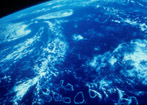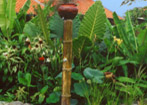|
Voyage from Palmerston
(S 18˚03'
W 163˚11')
to Apia, Samoa
(13°
49'S 171° 45' W)
Our voyage to Apia brought a visitor to the ship - a minke whale.
Michel hung off the side of the ship and she passed underneath him five
times - decreasing the distance between them until they were eventually
just metres apart.
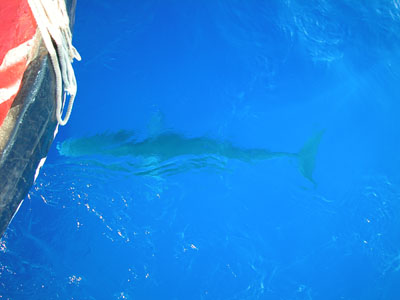
Our equinoctical celebrations were scuppered by weather but instead we
greeted the rising full moon - a moon that teased us with a reluctant
appearance, finally shining to our delight above a dense cloud bank.
Apia, Samoa
2nd October - 4th November, 2004
Our main focus here in Apia was to prepare the ship for the next phase of
the expedition - our voyage through the more remote and less visited
islands of the Pacific - Tokelau, Phoenix Islands (part of Kiribati) and
Tuvalu. We will be spending November to April in these waters which
lie north of 10°S and are therefore hopefully outside
the activity of the South Pacific cyclone belt. But a close
eye on weatherfaxes and radio ear to radio broadcasts will be required.
We were anchored in the harbour of Apia with cargo ships coming in and out
constantly, many other yachts anchored close to us and with winds that
caused the anchor to drag several times. But the most predominant
feature of the weather was the rain that came in sheets for days on end.
Along with the cyclone season has come the 'rainy season'!

day after day, this was our view through the portholes!
The rains became so heavy at one point that the river flowing into the
harbour broke its banks, bringing logs and rubbish past the ship in an
endless stream.
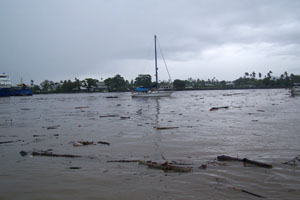
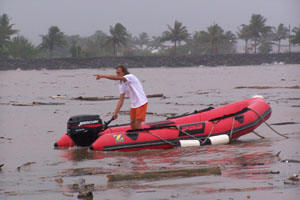
Michel takes a closer look at the debris running in from the river
We each took a day or two to get around the island, some even venturing to
Savai'i, the island next door, where the ship spent an amount of time
almost twenty years ago. Reports of waterfalls, blowholes,
plantations, food cooked underground, White Sundays at the churches for
the children - a feast of sights and activies.
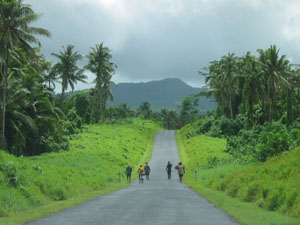
one of the mountain roads crossing the island of Upolu

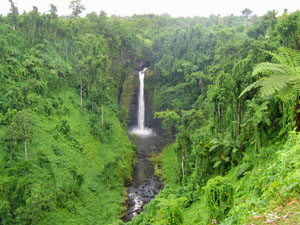
playspots for Samoans and Heraclitus crew alike!
One of our favourite spots in the town of Apia was the fresh food market -
continuously stocked with fresh foods from around the island and also a
great source for kava drinking, a juice squeezed from the kava root that
numbs the mouth and calms the mind.
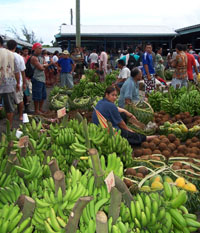

bananas and the kava cafe at the fresh food market
We bought fresh fish at the market, unable to catch our own in the harbour
- but most of the tuna caught locally is sent across to Pago Pago in
American Samoa where there are canning plants.
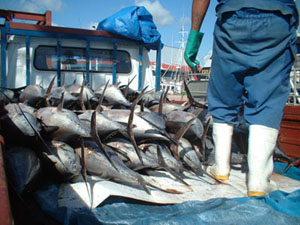
a fishing boat unloads its catch of tuna
And now we are ready - ready to find out the state of the reefs that are
hopefully less impacted than those we have already seen on our passage
from east to west across the South Pacific. And prepared to find out
if they are as pristine as they should be.
Western Samoa Dive Log
October, 2004
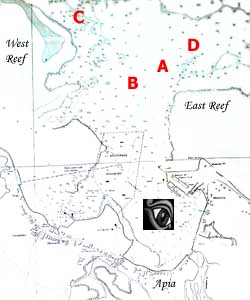
| Date: October 5th |
TI: 0900 |
TO: 0945 |
MaxDepth: 35m |
| Divers:
Michel, Lindsey, Albert
|
| Date: October 23rd |
TI: 1415 |
TO: 1450 |
MaxDepth: 27m |
| Divers: Michel, Rich, Hanna, Marco
|
| Date: October 25th |
TI: 1415 |
TO: 1450 |
MaxDepth: 27m |
| Divers: Michel, Orla
|

Upon entering the water, dolphins could be heard singing in the distance. We proceeded to swim through multiple caverns and trenches.
Giant patches of Diploastrea were present, as well as pink Pavona. But these were almost the only live corals on the reef.
The water here, outside the port of Apia, is very turbid, the visibility poor most of the time.
Most of the reef is dead - smothered in sediment and there are large amounts of algal overgrowth - some very beautiful shades of reds and green.
On the second dive here we found a narrow 20 foot long cavern.
After exploring the tunnel for over 20 minutes, we began our journey back to the small boat where a green turtle was spotted.
| Date: October 8th |
TI: 1503 |
TO: 1513 |
MaxDepth: 20m |
| Divers:
Michel, Hanna, Albert
|
This dive was the completion of Albert's PADI Rescue Diver certification - he rescued Hanna, who played the role of the "unconscious" diver.
Within 20 minutes Albert was able to get Hanna back to the ship and administer oxygen.
| Date: October 11th |
TI: 1037 |
TO: 1130 |
MaxDepth: 28m |
| Divers:
Michel, Keely, Nate, Hannah
|
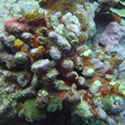
This was a Navigational Dive for Keely, Nate and Hannah's PADI Advanced Diver certification.
Hannah navigated our way back to the boat.
The dive started off following a slow descent along a trench. We then dropped off a wall to 25 metres.
The majority of the reef was dead, but there was a great diversity among the living corals including the genuses Astreopora , Cyphastrea , and Pavona .
Again, there were large amounts of algal overgrowth and sedimentation.
| Date: October 12th |
TI: 1415 |
TO: 1455 |
MaxDepth: 25m |
| Divers:
Michel, Albert, Rich, Marco
|

Albert's farewell to diving with the Heraclitus, and Rich and Marco's introduction. Like the previous dives, the majority of the reef lay in ruins.
Our focus during our stay here in Apia was to prepare the ship for the months ahead in more remote islands -
Tokelau, Phoenix Islands, Tuvalu.
All of the dives sites we visited outside of Apia Harbor were void of a healthy reef system, but
a snorkeling trip to the south side of the island showed the complete reverse - healthy corals and abundant fish life.
|



